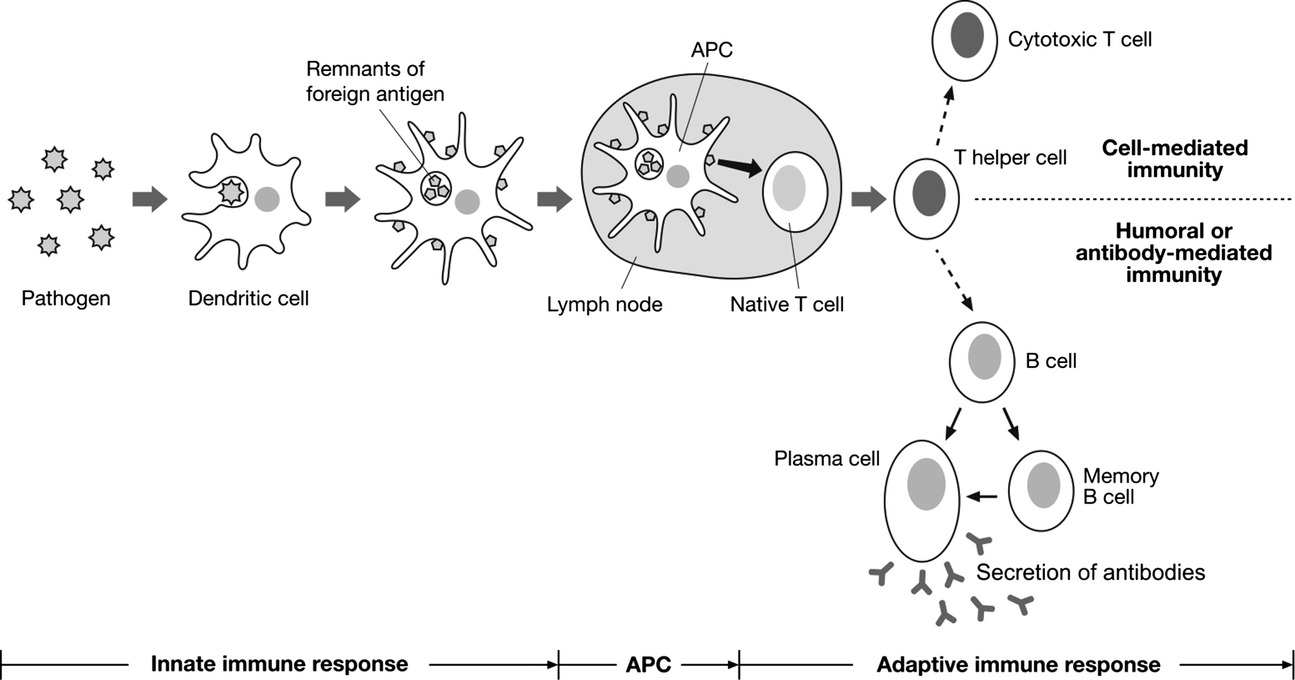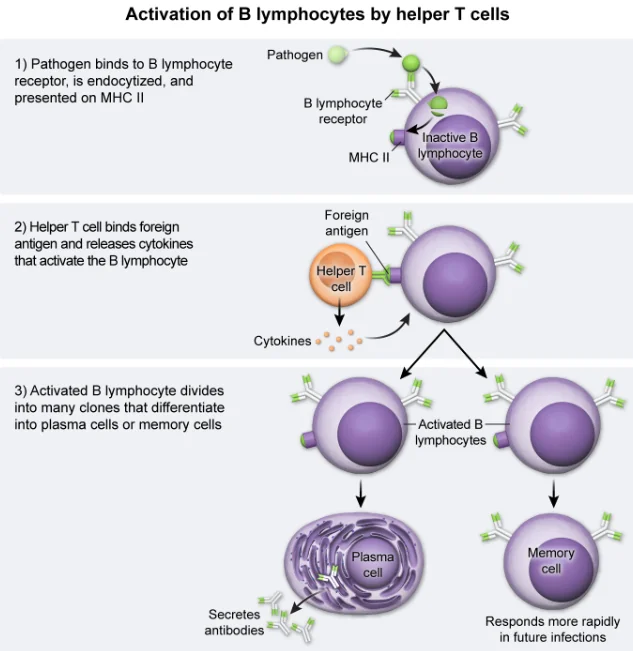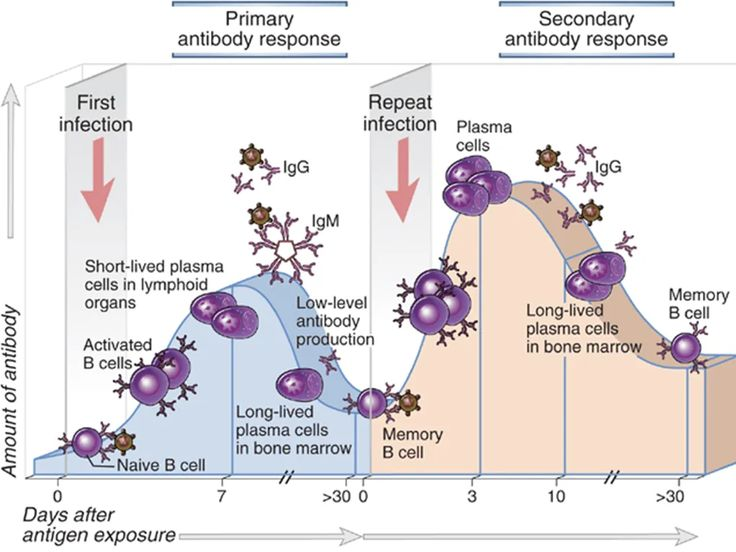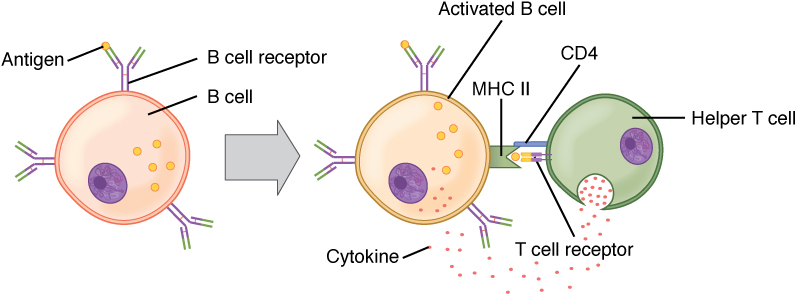11.05 B-Lymphocytes (B cells)
Types of Lymphocytes
Overview:
- Lymphocytes are a type of white blood cell smaller than phagocytes.
- Characterized by a large nucleus relative to their cell size.
Main Types of Lymphocytes
- B-Lymphocytes (B Cells)
- Maturation: Occur in the bone marrow.
- Primary Locations: Concentrate in lymph nodes and the spleen.
- Function: Each B cell is specific to one antigen and produces a corresponding antibody.
- T-Lymphocytes (T Cells)
- Maturation: Occur in the thymus gland.
- Thymus Growth: Grows until puberty, then gradually shrinks.
- Subtypes & Functions:
- Helper T Cells: Coordinate immune responses by stimulating B cells.
- Cytotoxic T Cells: Directly destroy infected or cancerous cells.
- Maturation: Occur in the thymus gland.
B-Lymphocyte Maturation & Function
Diversity of B Cells
- Variety: Approximately 10 million different B cell types.
- Specificity: Each B cell has a receptor specific to one unique antigen.
Clonal Selection and Expansion
- Clonal Selection:
- B cells with receptors that match an encountered antigen are selected for activation.
- Clonal Expansion:
- Selected B cells undergo rapid mitosis to increase their numbers, ensuring a sufficient immune response.
B Cell Receptors (BCRs)
- Specificity: Each BCR is tailored to bind a single specific antigen.
Key Processes in B Cell Function
- Primary Immune Response
- Initial Encounter: The first exposure to a new antigen.
- Characteristics: Involves slow clonal expansion and formation of plasma and memory cells.
- Secondary Immune Response
- Subsequent Encounters: Upon re-exposure to the same antigen.
- Characteristics: Faster and more robust response due to the presence of memory cells.

B Cells in the Immune Response
- Antigen Recognition
- Specific B cells bind to their matching antigen via BCRs.
- Clonal Selection and Mitosis
- Selected B cells undergo mitotic division to produce:
- Plasma Cells: Short-lived cells that produce large quantities of antibodies.
- Memory Cells: Long-lived cells that provide immunological memory for rapid response upon re-exposure.
- Selected B cells undergo mitotic division to produce:
- Antibody Secretion
- Plasma Cells:
- Production Rate: Capable of producing thousands of antibodies per second.
- Distribution: Antibodies are secreted into the bloodstream, lymphatic system, and mucosal linings.
- Memory Cells:
- Longevity: Can persist in the body for years or decades.
- Function: Enable a swift and effective secondary immune response upon re-infection with the same antigen.
- Plasma Cells:

Adaptations and Mechanisms
- Plasma Cells:
- Adaptations: Possess extensive endoplasmic reticulum and ribosomes to facilitate high-rate antibody production.
- Memory Cells:
- Role in Immunity: Serve as the foundation for long-term immunity, ensuring the body can quickly respond to previously encountered pathogens.


Key Terms
- Pathogen: An organism that causes disease.
- Antigen: A molecule on the surface of a pathogen that triggers an immune response.
- Clonal Selection: The process by which lymphocytes with receptors specific to an antigen are selected for activation.
- Clonal Expansion: The rapid division of selected lymphocytes to increase their numbers.
- Primary Immune Response: The initial response to a new antigen, characterized by slower activation and antibody production.
- Secondary Immune Response: A faster and more potent response upon re-exposure to the same antigen, mediated by memory cells.
- Plasma Cell: A differentiated B cell that produces and secretes antibodies.
- Memory Cell: A long-lived B cell that remains in the body to provide rapid responses upon future exposures to the same antigen.
Immune Response Summary
Steps in B Cell Activation:
- Antigen Binding:
- The B cell receptor binds to its specific antigen.
- Mitosis:
- The activated B cell undergoes mitotic division to produce plasma and memory cells.
- Antibody Secretion:
- Plasma Cells: Begin producing and secreting specific antibodies to neutralize the antigen.
- Memory Activation:
- Memory Cells: Remain in the body to enable a quick and effective response if the same antigen is encountered again.
Examples of Immune Memory
- Measles:
- Single Strain: Immune memory effectively prevents re-infection after recovery.
- Colds & Flu:
- Multiple Strains: Due to various strains with different antigens, each strain may require a primary response, leading to recurrent illnesses.
Questions Analysis
- Mitosis in Immune Response:
- Purpose: Ensures a rapid increase in the number of specific B cells to effectively target and eliminate the antigen.
- Plasma Cell Adaptations:
- Features: Extensive endoplasmic reticulum and abundant ribosomes allow plasma cells to produce antibodies efficiently and in large quantities.
